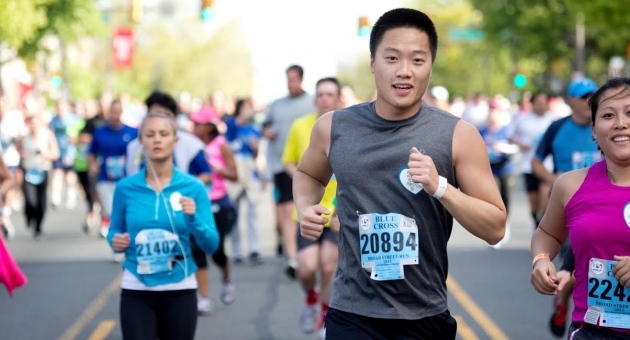Temple faculty experts talk Broad Street Run

The Blue Cross Broad Street Run (BCBSR) is one of the nation’s biggest road races and among Philadelphia’s most beloved annual events. Temple faculty members have been part of the BCBSR experience for many years, both as clinicians and as scholars who’ve studied the benefits of the race and running. Here Temple experts in podiatry, sport psychology and sport industry share their insights about and their tips for runners.
Reporters who would like to interview Temple experts on the BCBSR, running injuries, sport psychology, the impact of participatory sport events or other subjects should contact Hillel J. Hoffmann at hjh@temple.edu, 215-204-9699 or 215-255-5136.
HOWARD PALAMARCHUK: Avoiding injuries
No one knows more about the foot and ankle injuries that BCBSR runners suffer—and how to avoid them—than Howard Palamarchuk, director of sport medicine at Temple's School of Podiatric Medicine. For three decades, Palamarchuk and a team of Temple podiatry students have treated BCBSR runners who come to the medical tent near the finish line with foot or ankle complaints. The most common injuries? Blisters, said Palamarchuk, followed by nail problems, soft-tissue injuries (such as fasciitis and arch strain) and stress fractures.
Palamarchuk's advice for runners who want to prevent dreaded run-blisters: "Avoid getting your shoes and feet wet when you run through water stops. Don't wear no-name shoes from discount stores, and don't wear brand-new shoes to run your first race—running shoes need to be broken in. And if you do get a blister, never remove the skin roof once it’s drained or flattened."
Palamarchuk and his students have also treated runners at the Boston Marathon for the last 30 years. They were present at the finish line two years ago during the bomb attacks, when their tent became an emergency room and their attention shifted from treating foot injuries to saving lives.
MICHAEL SACHS: Race psychology tips
Long-distance road races can present special challenges for the relatively inexperienced runners who make up a considerable portion of BCBSR participants, said Michael Sachs, a sport psychology expert in Temple’s College of Public Health. Whether you’re a first-timer or someone who hasn’t run a race in years, Sachs advised not going out too fast and being prepared to adjust your pace—it’s crowded out there. Most of all, focus on completing the race and enjoying the moment.
“The goal for a first-timer should be to finish and finish comfortably,” he said. “The biggest challenge will be self-doubt. The general rule is you can complete a distance that’s three times the length of your regular training run. So put that self-doubt aside, don’t worry about your time and focus on finishing. If you feel you need to walk a bit, do it. The sense of achievement and pride that comes with completing the race will give you an unparalleled boost of self-esteem.”
JEREMY JORDAN: “People’s Race” benefits Philly
The BCBSR is more than just a race, said Jeremy Jordan, director of the Sport Industry Research Center at Temple’s School of Tourism and Hospitality Management. “The People’s Race” is a massive, high-profile event that has a positive impact on Philadelphia’s quality of life and economic health.
“The Blue Cross Broad Street Run is the largest 10-mile race and the eighth-largest road race of any distance in the U.S.—nearly 40,000 people participated last year,” said Jordan, who has researched BCBSR’s impact and will run in this year’s race. “People often talk about the positive impact of big spectator-sports events, but our research shows that participatory events can have bigger and broader effects. The tens of thousands of runners are supported by their friends and families, as well as all the people who come to watch and cheer, even if they don’t know any runners. And on top of the economic impact of all those visitors, the runners get the added bonus of fitness and psychological benefits.”